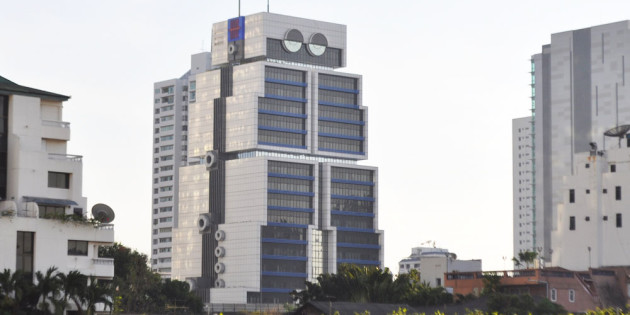Robot Building, Bangkok
The Robot Building is the current headquarters of United Overseas Bank and is located in the Sathorn business district of Bangkok, Thailand. Since its completion in 1987, it has come to be seen as one of the last examples of modernist architecture in the city.
It was designed by the Thai architect Sumet Jumsai for the Bank of Asia, with the intention of representing the increasing influence of computer technology on the banking industry. He was apparently inspired by seeing his young son’s plastic toy robot. Jumsai wanted the building to be a reaction against high-tech postmodern architecture, which he saw as being “a protest movement which seeks to replace without offering a replacement”.
To achieve the robot-like appearance of the 20-storey building, the sides step-back progressively in stages. This design technique also served as an efficient solution to the setback regulations that required an 18-degree incline from each side of the property line.
Two antennae on the roof serve as communications and lightning rods. The eyes are provided by two 6 m (19.7 ft) reflective glass windows looking out from executive meeting rooms, with eyelids made of metallic louvers. The building’s sides are adorned with ‘steel nuts’ made of glass-reinforced concrete, the largest of which measure 3.8 m (12.5 ft) in diameter, making them the largest in the world at the time of construction.
Despite some detractors, the Robot Building remains an icon of Bangkok architecture, and was selected by Los Angeles’ Museum of Contemporary Art as one of the 50 seminal buildings of the 20th century.
[edit] Related articles on Designing Buildings Wiki
- Big Duck.
- Building of the week series.
- Dancing House, Prague.
- Dunmore Pineapple.
- Fish Building, India.
- Fuji TV Building, Tokyo.
- Habitat 67.
- Lotus Temple.
- Lloyds of London.
- MahaNakhon, Bangkok.
- Metabolism.
- Ministry of Transportation Building, Georgia.
- Nakagin Capsule Tower.
- Office Center 1000 Kaunas.
- Owl House, South Korea.
- The Big Basket.
- The Gherkin.
- Unusual building design of the week.
Featured articles and news
The UK's Modern Industrial Strategy: A 10 year plan
Previous consultation criticism, current key elements and general support with some persisting reservations.
Building Safety Regulator reforms
New roles, new staff and a new fast track service pave the way for a single construction regulator.
Architectural Technologist CPDs and Communications
CIAT CPD… and how you can do it!
Cooling centres and cool spaces
Managing extreme heat in cities by directing the public to places for heat stress relief and water sources.
Winter gardens: A brief history and warm variations
Extending the season with glass in different forms and terms.
Restoring Great Yarmouth's Winter Gardens
Transforming one of the least sustainable constructions imaginable.
Construction Skills Mission Board launch sector drive
Newly formed government and industry collaboration set strategy for recruiting an additional 100,000 construction workers a year.
New Architects Code comes into effect in September 2025
ARB Architects Code of Conduct and Practice available with ongoing consultation regarding guidance.
Welsh Skills Body (Medr) launches ambitious plan
The new skills body brings together funding and regulation of tertiary education and research for the devolved nation.
Paul Gandy FCIOB announced as next CIOB President
Former Tilbury Douglas CEO takes helm.
UK Infrastructure: A 10 Year Strategy. In brief with reactions
With the National Infrastructure and Service Transformation Authority (NISTA).
Ebenezer Howard: inventor of the garden city. Book review.
The Grenfell Tower fire, eight years on
A time to pause and reflect as Dubai tower block fire reported just before anniversary.
Airtightness Topic Guide BSRIA TG 27/2025
Explaining the basics of airtightness, what it is, why it's important, when it's required and how it's carried out.
Construction contract awards hit lowest point of 2025
Plummeting for second consecutive month, intensifying concerns for housing and infrastructure goals.
Understanding Mental Health in the Built Environment 2025
Examining the state of mental health in construction, shedding light on levels of stress, anxiety and depression.






















